Report
Healthcare private equity market 2011: The year in review
While global private equity investment was generally stagnant in 2011, the healthcare sector saw exceptional growth (see Figure 1). The value of healthcare private equity deals doubled, from approximately $15 billion in 2010 to about $30 billion in 2011, despite a nearly 10% decline in the number of deals. That boosted healthcare’s relative importance, with the sector representing 15% of total global private equity investment activity and comprising 65% of the investment value among the year’s top 10 deals.
Supersized deals helped propel much of that growth. The 10 largest healthcare private equity acquisitions tallied $25 billion in 2011, up from about $10 billion in 2010 (see Figure 2). These deals spanned the full range of healthcare sectors, including medtech, pharma and healthcare providers and services. The three biggest deals—Kinetic Concepts (KCI), Pharmaceutical Product Development (PPD) and Emdeon—display that diversity. The slowing economy apparently did little to stall that market or the availability of leveraged finance, as each of these three deals closed in the second half of 2011.
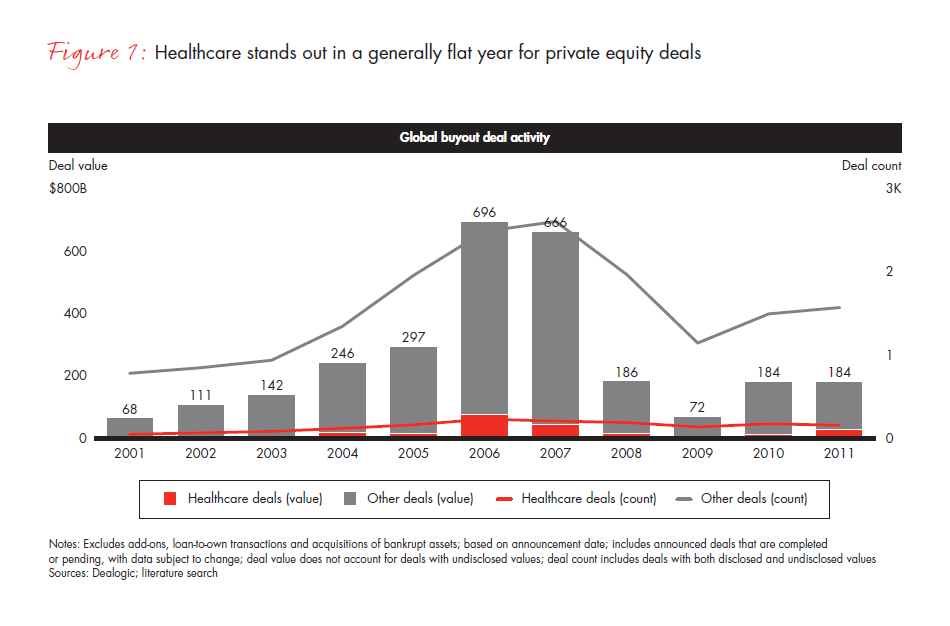
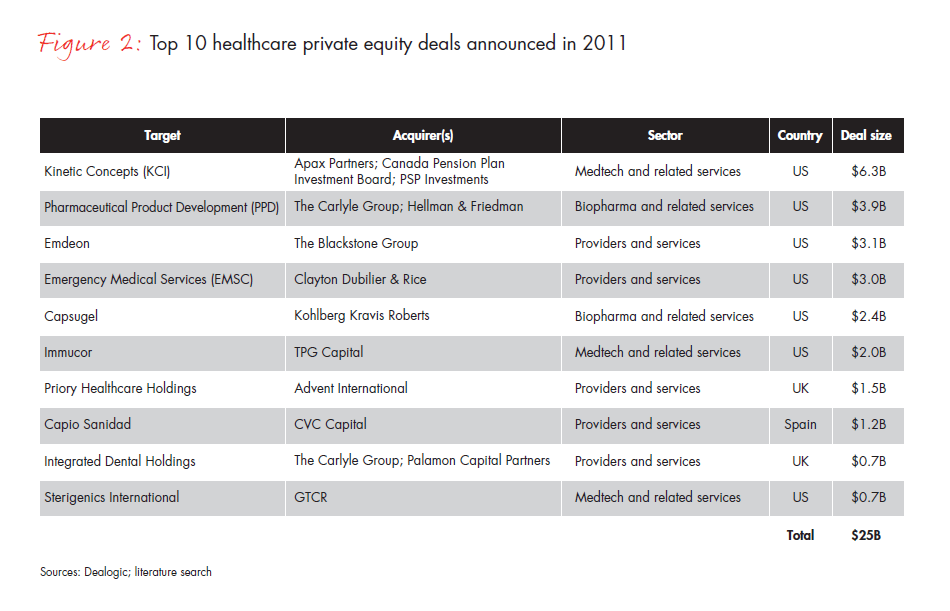
Investment activity levels varied meaningfully by sector
Three major sectors within healthcare—medtech, pharmaceuticals, and providers and services—captured some investor interest, but the level of growth within each one varied greatly. Direct investment in payers was very limited (see Figure 3).
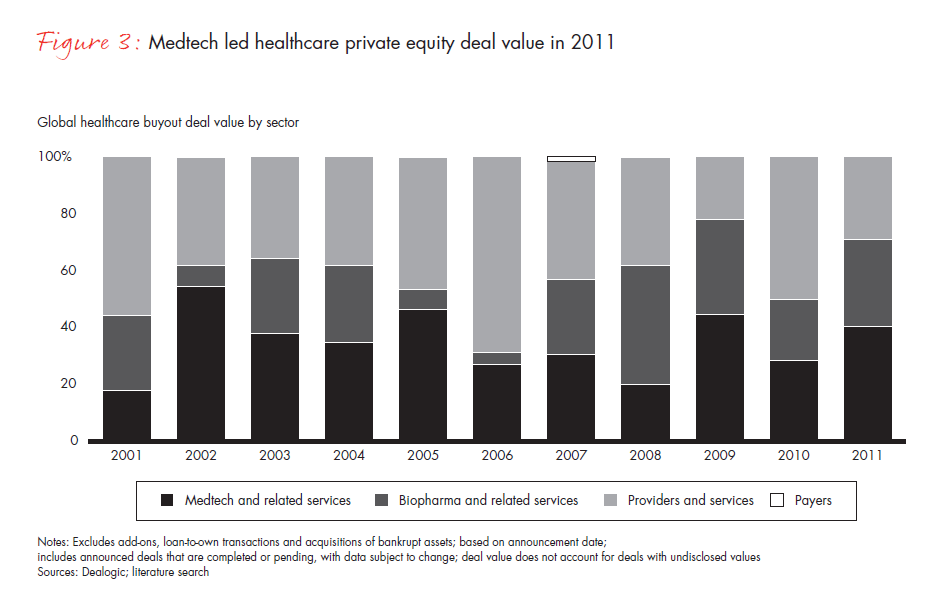
Medtech was the most popular sector last year, representing approximately 40% of overall healthcare private equity deal value, compared with 30% in 2010. Investors continued to fund deals in medtech, despite increasing price pressures and the commoditization of many categories. Those factors, however, put cost reduction and performance improvement at the top of the list of potential ways to improve deal value.
Deals in the medtech space included both product and service companies. On the product side, investments focused on technologies that are poised to ride demographic-driven volume bumps; they face limited pricing pressures and are innovative in ways that appeal to physicians. Some notable product-focused deals last year included KCI (acquired by Apax, Canada Pension Plan Investment Board, PSP Investments), Immucor (TPG Capital) and Physio-Control (Bain Capital). In the medtech product space, growth equity and venture funds are building a pipeline by investing across a wide spectrum of therapeutic service categories, including ophthalmology, cardiovascular, aesthetics and diagnostics. Private equity buyouts in the services subsector last year included Sterigenics International (GTCR), MarketLab (Water Street Healthcare Partners) and Orchid Orthopedic Solutions (Altor Fund).
Investments in the pharmaceuticals sector and related services also grew, from 20% of total private equity healthcare deal value in 2010 to about 30% in 2011. The hottest category in that sector continues to be contract research organizations (CROs), with investment theses aimed at riding the outsourcing wave and capitalizing on market consolidation. Some of the key CRO deals last year included PPD (acquired by Hellman & Friedman, The Carlyle Group), Medpace (CCMP Capital), PharmaNet/i3 (inVentiv Health, Thomas H. Lee) and Omnicare Clinical Research (Nautic Partners). Specialty pharmaceuticals also continue to be an area of focus, though strategic buyers are proving tough competition. The most notable specialty pharmaceuticals deal of the year was the sale of private equity-backed Nycomed to Takeda Pharmaceutical for €9.6 billion (about $13.7 billion).
The flow of capital to the healthcare provider and services sector dropped precipitously last year. Approximately 30% of overall deal value focused in this area, compared with 50% the year before. However, the sector saw many smaller deals, representing about 40% of the total number of private equity healthcare deals in 2011. This trend highlights the robust investment environment that exists in lower- to middle-market services companies. Notable areas of interest include physician practice management firms (Emergency Medical Services), ambulance services (Rural/Metro), retail healthcare (Integrated Dental Holdings, Accelerated Physical Therapy), diagnostic labs (Bostwick Laboratories, Diagnostyka), behavioral health (Priory Healthcare Holdings, Pyramid Healthcare, Reliant Hospital Partners), payer specialty benefits (Align Networks, CareCentrix, Matrix Medical Network) and revenue cycle management (Emdeon).
Healthcare investment remains concentrated on two continents
Geographic diversity is not yet a hallmark of the private equity healthcare investment landscape (see Figure 4). Seven of the top 10 targets in 2011 were based in North America (specifically in the US); the remaining three were in Europe (in the UK and Spain). While there is a great deal of investor interest in emerging economies (particularly in Brazil, China, India and Eastern Europe), there is a limited number of scalable assets to pursue in those regions at the moment.
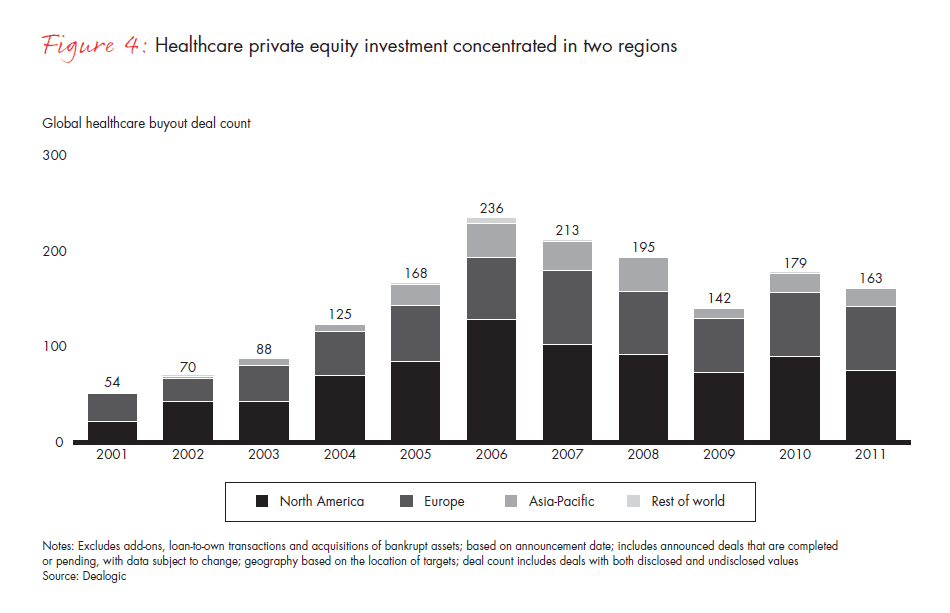
In the US, opportunities for healthcare investment are beginning to shift with the evolving regulatory and policy environment and weakening government and insurance reimbursement regimes. For the most part, investors in 2011 distanced themselves even further from categories with significant direct reimbursement risk, limiting deal activity in hospitals, home healthcare providers and payers (see Figure 5). The healthcare IT market is attractive, but deals have proven hard to execute, given the high valuations and competition from strategic buyers. In general, investment themes increasingly aim to capitalize on the regulatory and reimbursement trends by targeting companies that focus on hospital-physician alignment, new care-delivery methods and payment models, and consumer-directed healthcare options.
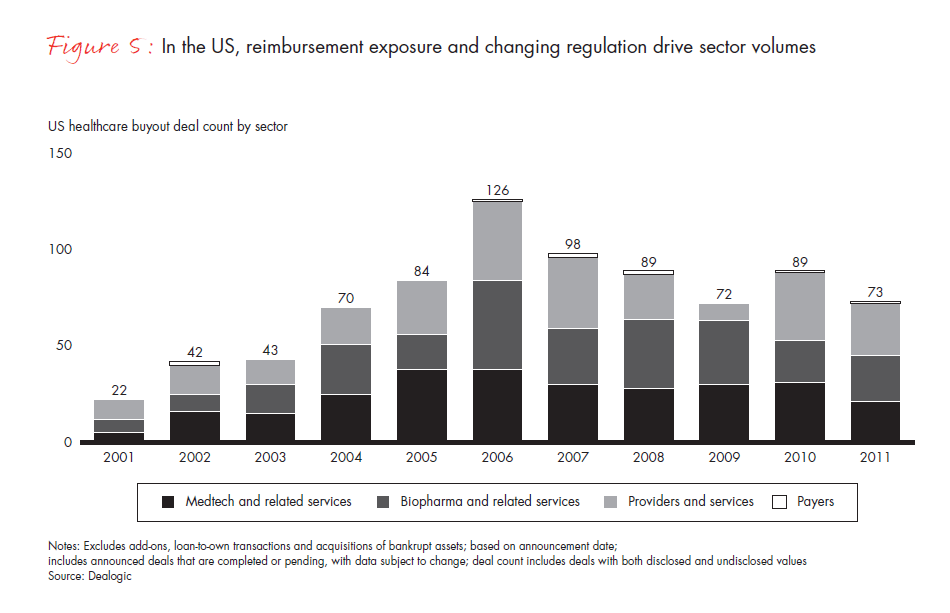
In Europe, healthcare investment has been more focused on areas with limited payer or government mandates on volumes and prices (see Figure 6). Products and services with a relatively high share of self-payers (such as dental and self-medication categories) or inevitable reimbursement (such as ostomy equipment, catheters and low-cost implantables) continue to be the most attractive to private equity. Last year, the top three deals in Europe were buyouts of services firms: Priory Healthcare, Capio Sanidad and Integrated Dental Holdings. Other services investments on the continent included diagnostic labs (Diagnostyka), post-acute care operators (Glenside Manor Healthcare, Curanum) and ambulance services (Ambulancies Reus, Ambuiberica). On the medtech front, deal activity included ophthalmology providers (Precilens and Polytech Ophthalmologie) and orthopedics companies (Evolutis, Intelligent Orthopaedics, Cellier Orthopedie and Amplitude).
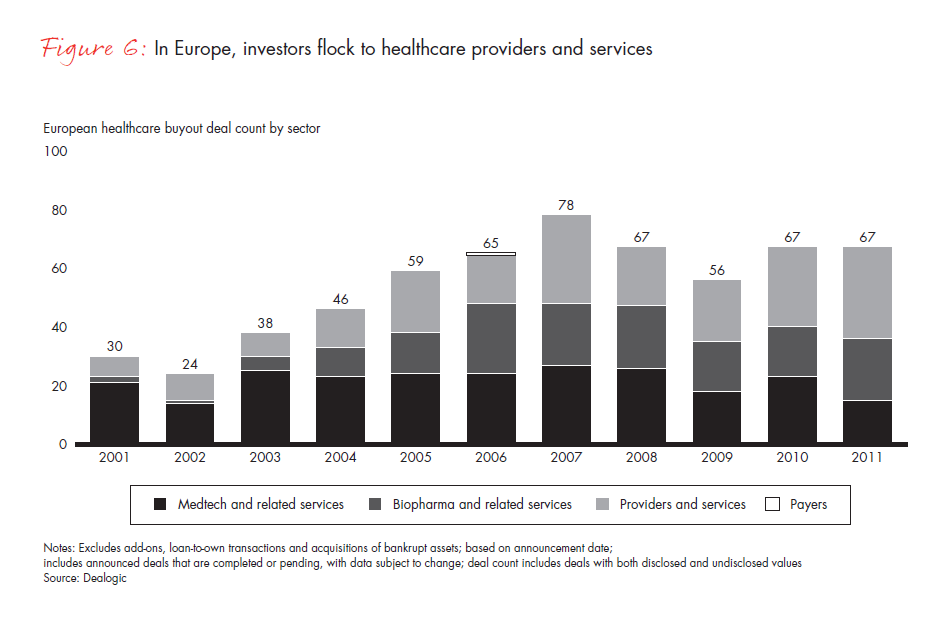
In emerging markets, private equity investments have been minimal to date, due in part to regulations that limit foreign investment in some countries. When investors enter such markets, they try to replicate themes that have been successful in developed markets. Provider and service plays are particularly in favor in markets like India. Investments in India include high-end hospitals, such as Fortis Healthcare, outpatient clinics, such as Kids Clinic, and diagnostic labs, such as Super Religare Laboratories. In China, investments were focused on pharmaceuticals and included Shandong Buchang Pharmaceutical and Guanghetang Herb-Tech.
Funds of all sizes participate, with outsized interest from mega funds
In the US, investment activity in the healthcare space was almost equally split between large and small private equity players. Funds with less than $1.5 billion under management drove 55% of investment activity in 2011, while funds with more than $1.5 billion accounted for 45%. Mega funds (those with more than $4.5 billion under management) showed the greatest growth, increasing from 10% of investment activity in 2009 to 25% in 2011 (see Figure 7).
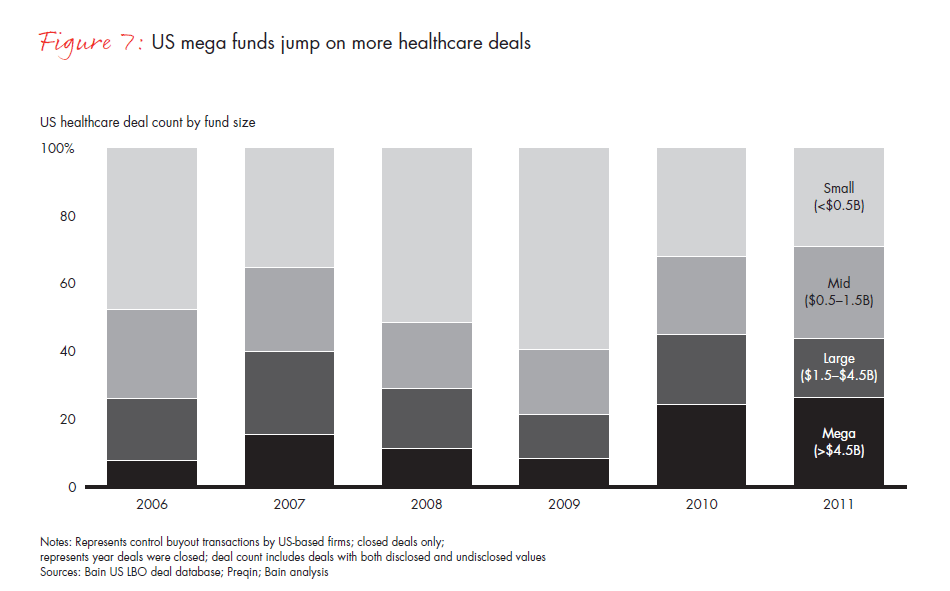
Mega funds are pursuing the largest deals, like KCI, PPD and Emdeon, but they are also increasingly exploring middle-market investment opportunities. There is a growing recognition that the middle market has a large number of potential targets well positioned to address the core market themes of driving better healthcare outcomes and lowering system costs. As a result, competition for middle market deals has intensified, now attracting a full range of fund sizes in addition to a broad set of strategic bidders.
In terms of the deal pipeline, half of all the companies that private equity funds bought in the US were privately held (see Figure 8), about the same level as 2010. Sponsor-to-sponsor deals (or secondary buyouts) accounted for 25% of the volume, while carve-outs comprised 20%.
Private equity buyouts of public companies represented only 5% of the mix, a sliver of deal volume. However, from a value perspective, the mix looks very different: Of the top 10 healthcare deals, four were public-to-private and one was a carve-out.
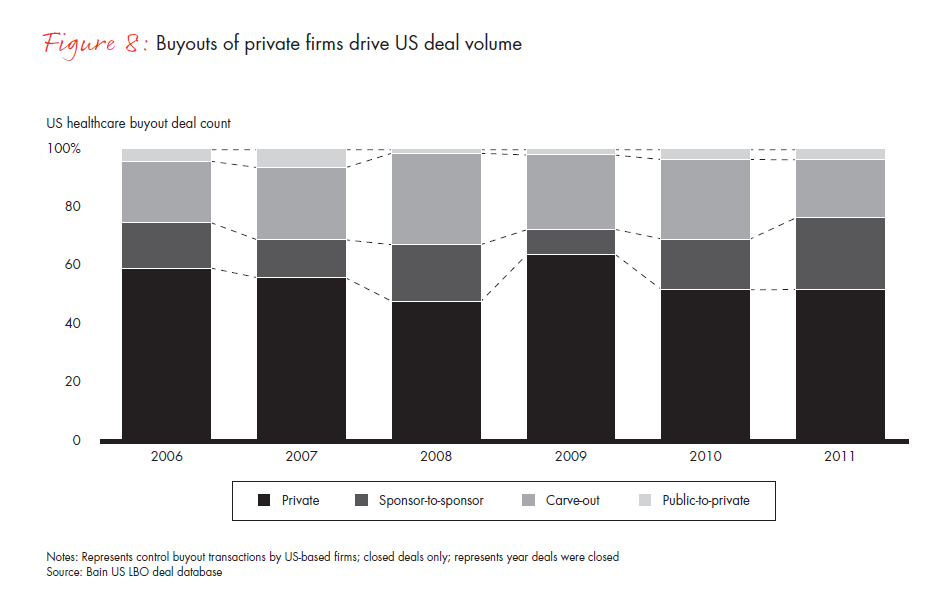
Strong competition from strategic buyers ups the ante for private equity investors
Overall, both the value and the volume of healthcare deals were flat from 2010 to 2011, with strategic and financial buyers creating just under $200 billion of total merger & acquisition (M&A) activity in each year (see Figure 9). Financial buyers (or buyouts) represented about 15% of the activity last year, a steady increase since 2009; but strategic investors still dominate. That dynamic increases purchase prices for private equity investors across healthcare sectors, but it may also offer rich exit opportunities.
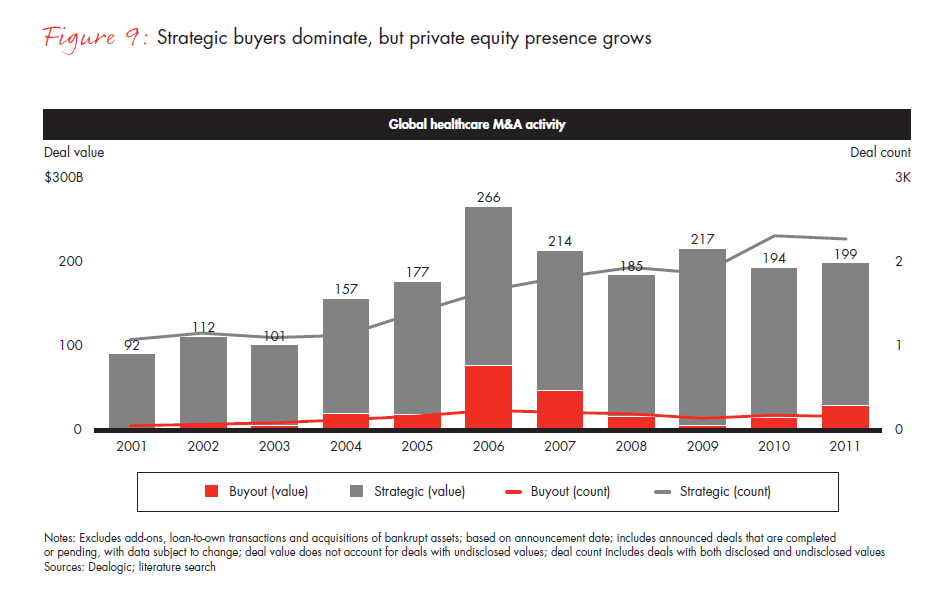
Strategic buyers have been strong in medtech acquisitions and will likely continue that trend heading into 2012. Recent strategic investment deals in medtech include Johnson & Johnson/Synthes ($21.3 billion), Danaher/Beckman Coulter ($6.8 billion), Thermo Fisher Scientific/Phadia ($3.5 billion), Endo Pharmaceuticals Holdings/American Medical Systems Holdings ($2.9 billion), Terumo/CaridianBCT Holding ($2.6 billion) and Dentsply International/ Astra Tech ($1.8 billion).
Strategic activity also continues apace in the pharma sector, especially as pharmaceutical companies seek to close gaps in their product pipelines. Notable recent deals in this area include Takeda Pharmaceutical/Nycomed (about $13.7 billion), Gilead Sciences/Pharmasset ($11 billion) and Teva Pharmaceutical Industries/Cephalon ($6.8 billion). Private equity investors will have to work even harder to carve out assets and build up specialty pharmaceutical portfolios to protect themselves from the competition.
Many companies in the healthcare provider and services sector are hot on the acquisition trail as well. Market leaders in particular are creating high transaction volumes as they seek to consolidate within their segments. Physician practice management firms, urgent care providers, long-term care providers and hospital companies were among the most active acquirers last year, with leading buyers including IPC The Hospitalist Company, MEDNAX, US HealthWorks Medical Group, National Mentor Holdings, The Ensign Group, Griffin-American Healthcare REIT II, Healthcare of Today, Community Health Systems, LTC Properties, AdCare Health Systems and Damp Holding.
Exit activity rebounds, though unevenly
While fervent interest from strategic players raises purchase prices for private equity buyers, the silver lining should be a frothy market for exits. Though 2011 was markedly slower than 2010 (see Figure 10), many exits played out as expected, with sales from private equity sponsors to strategic buyers accounting for about 60% of healthcare exits globally.
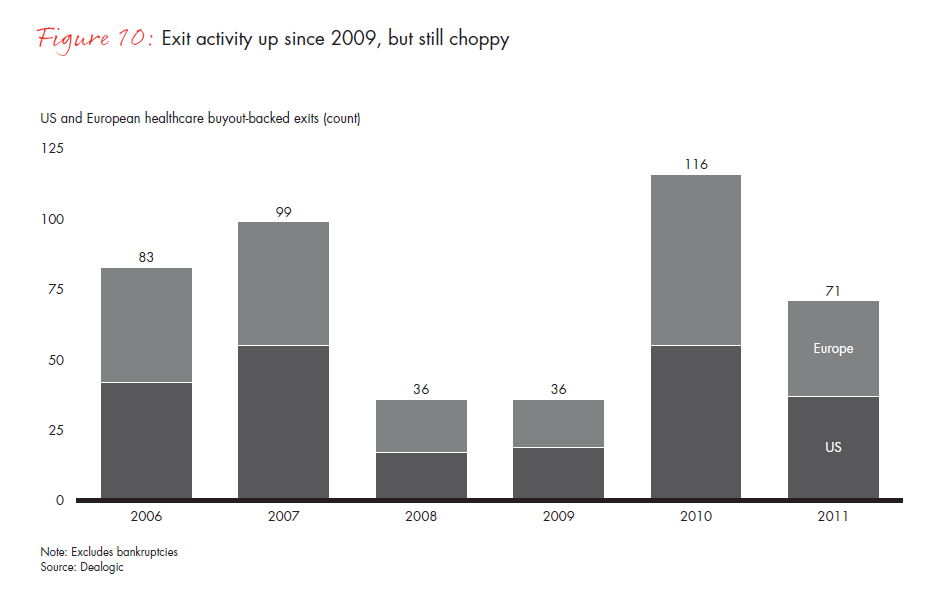
Sales of pharmaceutical firms and medtech companies topped the charts, with notable 2011 exits including Nycomed (about $13.7 billion), Phadia ($3.5 billion), BioVex Group (up to $1 billion), iNova Pharmaceuticals (about $700 million), Nucletron (about $500 million) and ProStrakan (about $475 million). In fact, the Nycomed deal made its mark even beyond the healthcare sector. It represented the largest private equity sale to a strategic buyer in Europe and the third-largest global deal to date. In addition, it offered the largest capital gain for private equity investors globally to date and was the second-biggest foreign acquisition by a Japanese company.
Other forms of exit also gained some traction. Medtech and services firms saw a number of IPOs, with hospital operator HCA Holdings topping the charts at approximately $4 billion. Sponsors Bain Capital and Kohlberg Kravis Roberts (KKR) generated meaningful returns from the deal, which was estimated at more than three times cash-on-cash returns. Other notable private equity-backed healthcare IPOs in 2011 included Qualicorp (about $588 million), Vanguard Health Systems ($450 million), China NT Pharma Group ($210 million) and Tornier ($180 million). Private equity funds provided liquidity in some cases as well. Notable sponsor-to-sponsor deals included Integrated Dental Holdings (about $720 million) and Sterigenics International ($675 million).
Future healthcare private equity market: Dynamics for 2012 and beyond
Looking at 2012 and beyond, major shifts are in store for the healthcare industry. Bain & Company estimates that the total annual global healthcare profit pool will grow solidly over the next decade, moving from approximately $500 billion to $550 billion in 2010 to as much as $750 billion in 2020. However, those profits will be reshuffled across sectors, as traditional winners like pharmaceuticals and medtech come under pressure and new categories emerge.
Within medtech, many of the historically attractive categories have come to maturation, meaning most future gains will come from successfully containing costs rather than rapidly growing revenues. Commodity or mainstream plays will require paying closer attention to performance improvement and more sophisticated account management and go-to-market models than have historically been required. There will still be investment opportunities in certain innovative niches, in some commoditized items (potentially even through underpriced “fighter brands”) and with service-based firms. Competition from strategic buyers will be high in the innovative niches, but growth equity and venture investors are likely to stoke the supply of new candidates. Many service-based investment opportunities, such as contract manufacturing and research, have not yet reached maturity and can provide key inroads to strategic partnerships.
In the pharmaceuticals sector, pharma services firms like CROs are likely to stay at the top of the list. Within the CRO space, there are a number of larger targets (for example, Covance, Parexel, ICON, Charles River) that could be interesting opportunities for investors willing to commit to new strategic models. More broadly, there are consolidation opportunities in the services sector that could allow for outsized profit margins, particularly in spaces like pharmaceutical compounding and specialty pharmacy products (though the latter has high reimbursement risk). As different types of pharma service firms pursue more cost-effective models, private equity investors may also find rewards in helping redesign their business models.
On the product side, the specialty pharmaceutical market will continue to be an area of keen investment focus and challenge, as strategic buyers fiercely compete and carve-outs demand an above-average degree of complexity. With reimbursement levels tenuous, categories that are less reliant on reimbursement, like animal health and aesthetics, will hold new appeal. Private equity firms are also trying to find an angle to create some long-overdue consolidation in the over-the-counter market.
Finally, healthcare providers and services—the sector that produced the highest deal volume in 2011—will become even more significant for private equity investors. Some of the popular investment targets of the recent past—such as physician practice management firms, retail health concepts, specialty benefits management firms, diagnostic labs, behavioral health resources, and fraud and abuse services—will continue to attract interest. New opportunities will also emerge. The rising role of the consumer could create more upside in opportunities like concierge medicine and aesthetic-focused service offerings, while the intensifying focus on efficient care delivery could generate more upside in innovative home care and primary care models. In general, investment themes will revolve around market leaders that show potential cost improvements and have a path to consolidation or additional customer up-sell.
In the US, as healthcare reform continues to evolve, investors may increasingly look at opportunities to help providers and payers shift to better cost-management models, such as integrated delivery systems that coordinate care across providers, and consumer-oriented healthcare purchase opportunities, such as private insurance exchanges. The main challenge with investing alongside healthcare reform goals from a services standpoint will be finding the right assets, especially given the relatively small size of most firms in the space and the uncertainty around the pace and direction of reform’s implementation. Pockets of opportunity may exist within healthcare IT, including areas such as niche sites of care, advanced analytics and informatics and payment integrity, though valuations are high. Managed-care investments are even higher risk, but returns may become attractive as governments lean more heavily on the private sector to manage Medicaid and Medicare members. We expect significant strategic interest in accountable care-oriented investments, including investments that stretch across historic boundaries (such as UnitedHealth Group’s acquisition of Monarch HealthCare).
In the providers and services category in Europe, diagnostic lab investment themes are top of mind for many investors, as meaningful consolidation is expected to occur over the next five years. Hospitals continue to be attractive in select geographies, such as Germany and France, where regulators avoid the direct intervention that occurs in others, such as the UK. In emerging markets, the focus will remain on replicating successful themes from developed markets and cultivating new asset-light delivery models. Across markets, the rising role of the consumer could create more upside in opportunities like concierge medicine and aesthetic-oriented service offerings. In general, investment themes will revolve around market leaders with a path to consolidation or additional customer up-sell and that show potential cost improvements in a relatively stable regulatory and market environment.
Healthcare will remain a large and attractive area for private equity investment, capturing from 10% to as much as 20% of total global private equity investment dollars in a given year. Many investors have made and will continue to make good returns in this industry. Looking ahead, however, investment success will hinge more than ever on the ability to stick closely to the macro themes of driving greater efficiency in the healthcare system and improving healthcare outcomes.
Acknowledgments
This report was prepared by Kara Murphy and Claudia Amstutz. The authors would like to thank Chris Koegel and Amy Witt for their contributions; Brenda Rainey for her support; and John Peverley, Emily Lane, Laura Fase and Michael Fournier for their research.
We are grateful to Dealogic and Preqin for the valuable data they provided and for their responsiveness to our special requests.
This work is based on secondary market research, analysis of financial information available or provided to Bain & Company and a range of interviews with industry participants. Bain & Company has not independently verified any such information provided or available to Bain and makes no representation or warranty, express or implied, that such information is accurate or complete. Projected market and financial information, analyses and conclusions contained herein are based on the information described above and on Bain & Company’s judgment, and should not be construed as definitive forecasts or guarantees of future performance or results. The information and analysis herein does not constitute advice of any kind, is not intended to be used for investment purposes, and neither Bain & Company nor any of its subsidiaries or their respective officers, directors, shareholders, employees or agents accept any responsibility or liability with respect to the use of or reliance on any information or analysis contained in this document. This work is copyright Bain & Company and may not be published, transmitted, broadcast, copied, reproduced or reprinted in whole or in part without the explicit written permission of Bain & Company.









